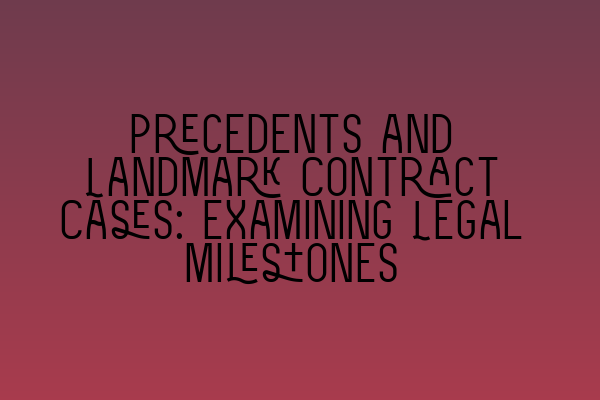Precedents and Landmark Contract Cases: Examining Legal Milestones
As solicitors, it is crucial for us to understand the significance of precedents and landmark contract cases in our practice. These legal milestones provide guidance, shape our interpretation of the law, and set the standards for future negotiations and agreements. In this blog post, we will dive deep into the world of contract law and explore some of the most important precedents and landmark cases that have shaped the legal landscape.
Before we begin our journey through the legal milestones, it is worth noting the importance of staying up-to-date with relevant legal challenges and pitfalls that may arise in our practice. Navigating these challenges effectively can make a significant difference in the outcome of our cases. If you’re interested in learning more about this topic, I highly recommend checking out the article “Navigating Legal Challenges and Pitfalls in Your Practice” for valuable insights.
Now, let’s explore some of the most influential precedents and landmark contract cases:
1. Hadley v. Baxendale (1854):
This landmark case established the principle of foreseeability of damages in contract law. It held that in order to claim damages for a breach of contract, the damages must have been reasonably foreseeable by both parties at the time of contracting. This case has had a significant impact on how courts determine the extent of damages in contract disputes.
2. Carlill v Carbolic Smoke Ball Co. (1893):
This precedent-setting case involved a contract for a smoke ball that allegedly prevented influenza. The court held that the advertisement constituted an offer, and the act of using the smoke ball as directed constituted acceptance. This case introduced the concept of unilateral contracts, where performance of an act constitutes acceptance of an offer, even in the absence of direct communication.
3. The Moorcock (1889):
In this case, the court recognized the implied term of reasonable care and skill in contracts. The court held that parties entering into a contract have an obligation to exercise reasonable care and skill to ensure that the contract is fulfilled as intended. This landmark ruling has had a significant impact on the standards expected of professionals in various contractual relationships.
4. Holwell Securities Ltd v. Hughes (1974):
This case established the principle of implied terms in contracts. It held that terms can be implied into a contract based on the presumed intention of the parties and the background circumstances. The decision expanded the scope of contractual obligations beyond the explicit terms, allowing the courts to interpret the intentions of the parties comprehensively.
5. Shirlaw v Southern Foundries (1926):
The principle established in this case is known as the “Business Efficacy Test.” It states that terms may be implied in a contract if they are necessary to give business efficacy to the agreement. This ruling has been influential in determining whether implicit terms should be implied into commercial agreements.
These are just a few examples of the many precedents and landmark contract cases that have shaped contract law as we know it today. Each case has contributed to the evolution and interpretation of contractual principles and has set important precedents for future disputes and negotiations.
Understanding these legal milestones is essential for solicitors, as it allows us to approach our work with knowledge and expertise. It is also crucial to keep up with the evolving legal landscape and stay informed about the SRA Competence Statement. If you want to learn more about this statement and its implications for solicitors, I highly recommend reading the article “Understanding the SRA Competence Statement: A Guide for Solicitors.”
As solicitors, we may choose to specialize in specific areas of law. If you’re interested in exploring different solicitor specializations and finding your niche, I encourage you to check out the informative article “Exploring Different Solicitor Specializations: Finding Your Niche.” This resource provides valuable insights and recommendations for finding your passion within the legal profession.
Lastly, if you’re considering a career in law and are looking for top recommendations for law schools in the UK, I recommend checking out the article “Top Recommendations for Law Schools in the UK.” It provides a comprehensive list of reputable institutions that can help you kickstart your legal education.
In conclusion, precedents and landmark contract cases play a crucial role in shaping contract law and guiding solicitors in their practice. Understanding and analyzing these legal milestones can provide valuable insights into the interpretation and application of contractual principles. By staying up-to-date with legal challenges, understanding the SRA Competence Statement, and exploring different solicitor specializations, we can ensure that we are well-equipped to navigate the ever-evolving legal landscape effectively.
Sources:
– Navigating Legal Challenges and Pitfalls in Your Practice
– Barrister vs. Solicitor: A Comprehensive Comparison
– Understanding the SRA Competence Statement: A Guide for Solicitors
– Exploring Different Solicitor Specializations: Finding Your Niche
– Top Recommendations for Law Schools in the UK
